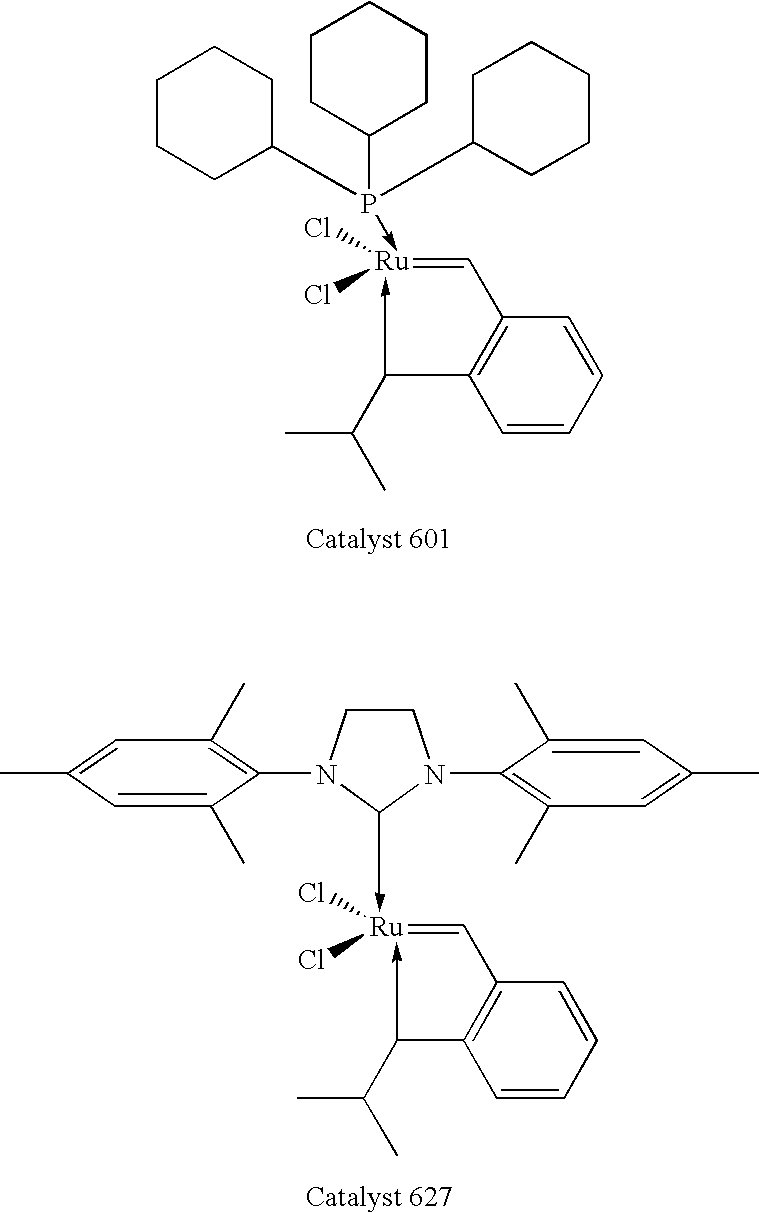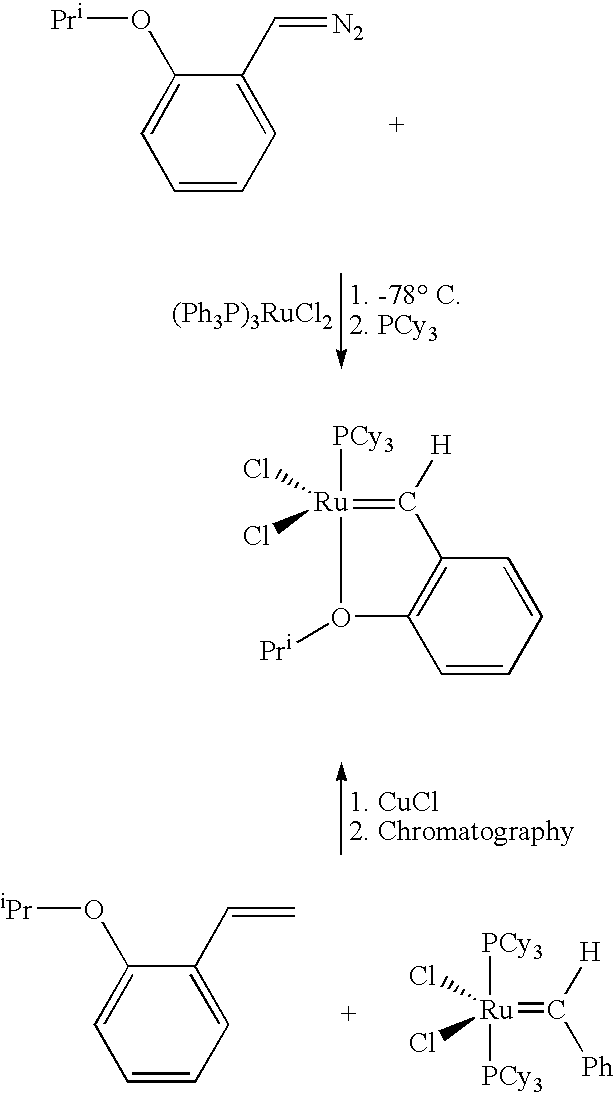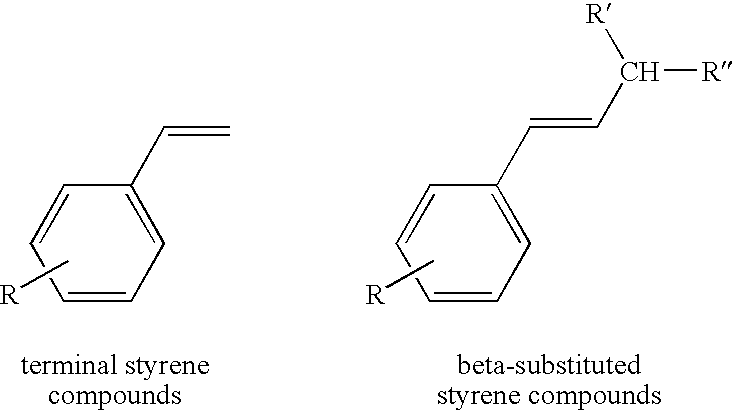Chelating carbene ligand precursors and their use in the synthesis of metathesis catalysts
a technology of chelating carbene ligand and precursors, which is applied in the direction of physical/chemical process catalysts, ruthenium organic compounds, osmonium organic compounds, etc., can solve the problems of large-scale synthesis of cucl, and achieve the effect of high yield of hoveyda-type metathesis catalysts
- Summary
- Abstract
- Description
- Claims
- Application Information
AI Technical Summary
Benefits of technology
Problems solved by technology
Method used
Image
Examples
example 1
[0034]Synthesis of o-hydroxy beta-methyl styrene [1] from 2-allylphenol. To a dry 100 mL round-bottom flask containing a magnetic stirbar was added 25 g (186 mmol) of 2-allylphenol (Aldrich). The flask was sparged with argon for 30 minutes, followed by the addition of 71 mg (0.05 mol %) of (PPh3)2Cl2Ru, a highly effective double-bond isomerization catalyst, and then heated to 70° C. for 17.5 hours. GC analysis* indicated >99% conversion of 2-allyl phenol to o-hydroxy beta-methyl styrene. GC results show ortho-hydroxy beta-methyl styrene Rt 8.51 minutes and Rt 11.13 minutes (Z and E Isomers), and 2-allylphenol Rt 8.86 minutes. The catalyst was removed with tris-hydroxymethyl phosphine (THP), as previously described by Pederson and Grubbs [U.S. Pat. No. 6,219,019], to yield 25 g, quantitative yield. Isomeric ratio of E:Z isomers was 45:55.
[0035]*GC Analysis: HP 5890 GC with DB 225 capillary GC column (30 m×0.25 mm ID×0.25 um film thickness) Head pressure 15 psi, FID detection. Method:...
example 2
[0036]Synthesis of ortho-Isopropoxy beta-Methyl Styrene [2]. Protection of an aromatic hydroxyl group with isopropyl was as described by T. Sala and M. V. Sargent, J. Chem. Soc., Perkin Trans. 1, 2593, (1979). To a dry 500 mL round-bottom flask containing a magnetic stirbar was added 50 g (373 mmol) of ortho-hydroxy beta-methyl styrene, 57.3 g (466 mmol) isopropyl bromide, 300 mL of anhydrous dimethylformamide (DMF), and 64 g (466 mmol) K2CO3. The heterogeneous mixture was warmed to 60° C. After 9 hours the reaction was 57% converted, 30 g (244 mmol) isopropyl bromide and 32 g (232 mmol) of K2CO3 was added, and stirring was continued. After 48 hours, GC analysis indicated >98% conversion to ortho-isopropoxy beta-methyl styrene. GC results: ortho-hydroxy beta-methyl styrene Rt 8.51 minutes and Rt 11.13 minutes (Z and E isomers), ortho-isopropoxy beta-methyl styrene Rt 7.35 minutes (Z-isomer) and Rt 8.30 minutes (E-isomer).
[0037]The reaction was cooled to room temperature and 200 mL o...
example 3
[0039]Alternative Synthesis of ortho-Isopropoxy beta-Methyl Styrene 121: Synthesis of ortho-Isopropoxy Salicylaldehyde [3]. Similar to the procecure of Example 2, 6.5 g (53.2 mmol) of salicylaldehyde, 100 mL of anhydrous DMF, 6.5 g of K2CO3, and 10 g of isopropyl bromide (81.3 mmol) were added to a dry 250 nL round-bottom flask containing a magnetic stirbar. The heterogeneous mixture was stirred with heating to 60° C. for 24 hours when GC analysis indicated complete conversion to o-isopropoxy salicylaldehyde. Water 100 mL was added and the organics were washed with 2×100 mL of TBME, the TBME phases were combined and washed with 2×50 mL water, dried with anhydrous sodium sulfate, filtered and concentrated to yield [3] (8.3 g, 95% yield). Salicylaldehyde Rt 6.473 minutes, ortho-isopropoxy salicylaldehyde Rt 10.648 minutes. 1H NMR (300 MHz) CDCl3 δ: 10.46 (CHO), 7.8 (d, 1H aromatic), 7.5 (m, 1H, aromatic), 6.90 (t, 2H, aromatic), 4.64 (m, 1H, CH(CH3)2, 1.35 (J 6.3 Hz, 6H, CH(CH3)2.
PUM
 Login to View More
Login to View More Abstract
Description
Claims
Application Information
 Login to View More
Login to View More - R&D
- Intellectual Property
- Life Sciences
- Materials
- Tech Scout
- Unparalleled Data Quality
- Higher Quality Content
- 60% Fewer Hallucinations
Browse by: Latest US Patents, China's latest patents, Technical Efficacy Thesaurus, Application Domain, Technology Topic, Popular Technical Reports.
© 2025 PatSnap. All rights reserved.Legal|Privacy policy|Modern Slavery Act Transparency Statement|Sitemap|About US| Contact US: help@patsnap.com



